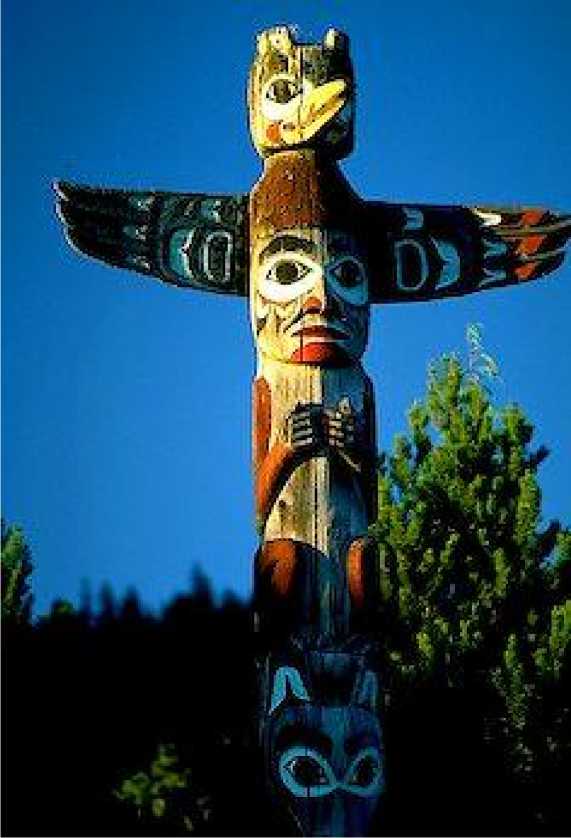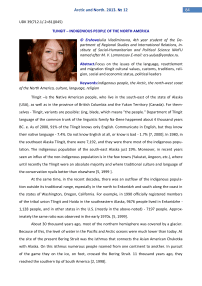Tlingit – indigenious people of the North America
Автор: Ershova J.V.
Журнал: Arctic and North @arctic-and-north
Рубрика: Indigenous people of the Arctic and North
Статья в выпуске: 12, 2013 года.
Бесплатный доступ
Focus on the issues of the language, resettlement and migration tlingit cultural values, customs, traditions, religion, social and economic status, political leaders.
Indigenous people, the Arctic, the north-west coast of the North America, culture, language, religion
Короткий адрес: https://sciup.org/148320337
IDR: 148320337 | УДК: 39(712.1/.2=81)(045)
Текст научной статьи Tlingit – indigenious people of the North America
Tlingit –is the Native American people, who live in the south-east of the state of Alaska (USA), as well as in the province of British Columbia and the Yukon Territory (Canada). For themselves - Tlingit, variants are possible: Ling, blade, which means "the people." Department of Tlingit language of the common trunk of the linguistic family Na-Dene happened about 4 thousand years BC. e. As of 2000, 91% of the Tlingit knows only English. Communicate in English, but they know their native language - 7.4%. Do not know English at all, or know is bad - 1.7% [7, 2000]. In 1980, in the southeast Alaska Tlingit, there were 7,192, and they were there most of the indigenous population. The indigenous population of the south-east Alaska just 19%. Moreover, in recent years seen an influx of the non-indigenous population is in the few towns (Yakutat, Angoon, etc.), where until recently the Tlingit were an absolute majority and where traditional culture and language of the conservation nyalis better than elsewhere [5, 1999 ].
At the same time, in the recent decades, there was an outflow of the indigenous population outside its traditional range, especially in the north to Enkoridzh and south along the coast in the states of Washington, Oregon, California. For example, in 1990 officially registered members of the tribal union Tlingit and Haida in the southeastern Alaska, 9676 people lived in Enkoridzhe -1,128 people, and in other states in the U.S. (mostly in the above-noted) - 7197 people. Approximately the same ratio was observed in the early 1970s. [5, 1999].
About 30 thousand years ago, most of the northern hemisphere was covered by a glacier. Because of this, the level of water in the Pacific and Arctic oceans were much lower than today. At the site of the present Bering Strait was the isthmus that connects the Asian American Chukotka with Alaska. On this isthmus numerous people roamed from one continent to another. In pursuit of the game they on the ice, on foot, crossed the Bering Strait. 11 thousand years ago, they reached the southern tip of South America [2, 1998].
The original homeland of the Tlingit people, according to Indian tradition, located to the southeast of the modern ethnic territory, near the mouths of the Nass and Skeena rivers, from which began the resettlement of births in the north [1, 1991]. Tlingit did not migrate to the south. This can be explained by the fact that in the south and south-east of the warlike tribes inhabited Haida and Tsimshian, Tlingit not inferior in the terms of the socio-economic development. Tlingit culture belonged to the resident anglers. That pressure Tsimshian from the south-east and led, apparently, to the Tlingit migration to the north. Haida Indians also sought expansion. Haida invasion from the south led to the relocation of a number of tlinkistskih birth to Prince of Wales Island on the coast of the mainland, as well as assimilation and marginalization Athabaskan population [1, 1991].
From an ethnographic point of the view in the Tlingit tribe can be divided into four main groups: one belonged to the southern (coastal) Tlingit, to another - the northern (coastal), the third - the Gulf of Alaska Tlingit and, finally, the last group was comprised of inland Tlingit [1, 1991 ]. Southern Tlingit occupy the mainland coast and the adjacent islands from Portland Canal in the south to the Straits, and Frederick Cheetham in the north. To the north of this boundary to the Gulf Ltua lived northern Tlingit. In the area of Yakutat and Dry Bay by the end of the XVIII century. Tlingit community formed the Gulf of Alaska, and only later, in the XIX century., in the upper reaches of the Taku and Yukon formed two modern inland Tlingit community.
Cultural differences are sharply contrasted the Tlingit of the first three groups (coastal residents) their inland relatives, which differed little on the way of life of neighboring Athabascan. Among the coastal Tlingit still existed a small cultural differentiation. Thus, the southern group experienced greater influence its neighbors to the south - the Haida and Tsimshian than northerners. At the same time, the Gulf of Alaska Tlingit still retained some of the cultural features of the Athabascan and eyakoyazychnyh ancestors [1, 1991].
Religious beliefs of the Tlingit were the entire complex consisting of yavshy-totems, animalism (a genre of fine art, the object of which is based animal), fetishism, magic, animism and shamanism. A special place is occupied totemizm [1, 1991]. Tlingit conception of the world was peculiar primitive syncretism: the man was an organic part of nature and is not opposed to the rest of the world. Tlingit believed that in the afterlife the soul of man occupies the same place, which he had in life. Land, according to the Tlingit myths, resting on a giant pillar in the form of a beaver's front legs, which kept the old underground Agishanuku. Earth, according to representations of the Tlingit, stands on a huge column that stores and maintains Agishanuku, otherwise the earth would long ago have capsized and sank in the sea. Earthquakes occur because of the struggle Agishanu- ku-Man Raven Yelom. Yel, angry at people for their failure to comply with its covenants, trying to pull the old woman from the pole and overturn the earth. Agishanuku to help cope with her powerful opponent, the Indians during earthquakes ran out of their homes, sat down and began to drag each other's sticks, accompanying these actions magical songs [1, 1991].
Shamans in Tlingit revered more than the other Indians of the Northwest Coast. The Indians believed that the shaman can be mediators between the human world and the spirit world. Last supposedly helped to see the future, find a sorcerer, or a thief, cure diseases, prevent hazards, etc. While the shaman could be anyone - a man and a woman - in Tlingit shaman were relatively rare [3, 1985]. Shaman could have several spiritual patrons. The more they have, the more numerous were shamanic supplies, it was considered more influential. For each of the spirit was their name and their songs. Ecstasy is usually called a shaman singing, beating the tambourine, ecstatic dancing. Apparently, the Tlingit shamans used in his practice hypnosis and self-hypnosis, and often achieved with the help of their desired results, especially in the treatment of the patients, as well as in the determining the thief [1, 1991].
Today Tlingit - Orthodox and Protestant (Presbyterian, "Salvation Army")1. Information about the pagan religion I found.
Tlingit country was divided into the territorial units - kuany (Sitka, Yakutat, Hoonah, Huts-nuvu, Akoya, Stikine, Chilkat, etc.). Each of them could be several large winter villages, inhabited by the representatives of the different genera (clans sibov) belonging to two large moieties of the tribe - Wolf / Eagle and the Raven. These clans - kiksadi, kagvantan, deshitan, tluknahadi, tekuedi, nanyaayi, etc. - are often at odds with each other. It is generic, and clan ties were the most significant and durable in Tlingit society [4, 2002].
Far enough, like many other tribes of the Northwest Coast, has gone from the Tlingit social stratification. Each had its own Kuan people of high rank - anyadi, which included also the chiefs of villages, clans, heads of households; commoners - Tlingit or kanashkide and slaves. Tlingit traders vigilantly guarded the sphere of influence of the penetration of unwanted competitors, whether Indian or white [4, 2002].
Tlingit economy to dealing with other people had the natural character of the economy. Cash and the American system of ownership dramatically changed the lifestyle of the Tlingit people, but many of them have successfully adapted. Their main activities are related to logging and forestry, fishing and marine industry, tourism. Because of the emphasis on education, a significant number of the Tlingit people - lawyers, doctors and teachers. "Sialyaska" and ANCSA Village
Corporation also provide jobs in the area of office management and corporate governance. Not all positions in corporations occupy the Tlingit and Haida, since a large number of jobs are filled by non-indigenous people. Some of the Tlingit are quite economically disadvantaged and have fewer opportunities2. Employment indigenous men - 67.5%, women - 62%. In the field of management -25.6% of the indigenous population, the service - 20.0%, office and trade - 27.2%, farming, hunting and fishing - 3.0%, construction, production, and maintenance - 10.1% production, transportation and material moving - 14.2% [7, 2000].
Much of the Tlingit people live in thetraditional villages, apprehended many elements of the modern American material culture. The value of labor fell, but remained bolshesemeynye communication, many tribal traditions and some traditional institutions, the practice of pot- latches, partly tongue, traditional food and crafts (to him in the XIX century. Added manufacturer of silver jewelery.)

Pic 1. Tilingitswoodcarving. URL:
Among the Tlingit have outstanding leaders in the government, one of them - Paul William (1885-1977). He started as a graduate law school and practicing the lawyers and the first Tlingit participating in the activities of the representative body of the State of Alaska (Alaska's territorial House of Representatives); contributed to the empowerment of the Tlingit people equal rights, was engaged in the settlement of land issues. One of the brightest leaders was Peratrovich and Frank J. (1895-1984), the University of Alaska received an honorary doctorate of the public service. He was the first Tlingit, sitting in the Senate in Alaska, and then the first Tlingit, the chairman of the Senate [6, 2006].
Список литературы Tlingit – indigenious people of the North America
- Grinev A.V.Tlingit Indians in Russian America period (1741-1867). Novosibirsk: "Science" article. Branch, 1991. 320p.
- Z. Zeiler Indians. Translation Zamesskoy BI Moscow: Word, 1998. 148P.
- Olson R. L. Social Structure and Social Life on the Tlingit Indians of Alaska. N. Y., 1985. 111 p.
- Zorin A.V. Indian War in Russian America. 2002. URL: http:// www.mezoamerica.ru / indians / north / tarakanov.html (date of access: 14.05.2011).
- Shnirelman VA Formation of the ethnicity: Tlingit of Southeast Alaska at the end of the XX century. 1999. URL: http://www.etnograf.ru/node/66/ (date of access: 17.05.2011).
- Benson D. E. Tlingit. 2006. URL: http://www.everyculture.com/multi/Sr-Z/Tlingit.html (date of access: 29.04.12).
- Ogunwole Stella U. We the People: American Indians and Alaska Natives in the United States. Census. 2000. Special Reports. URL: http://www.census.gov/prod/2006pubs/censr- 28.pdf (date of access: 17.05.2011).


